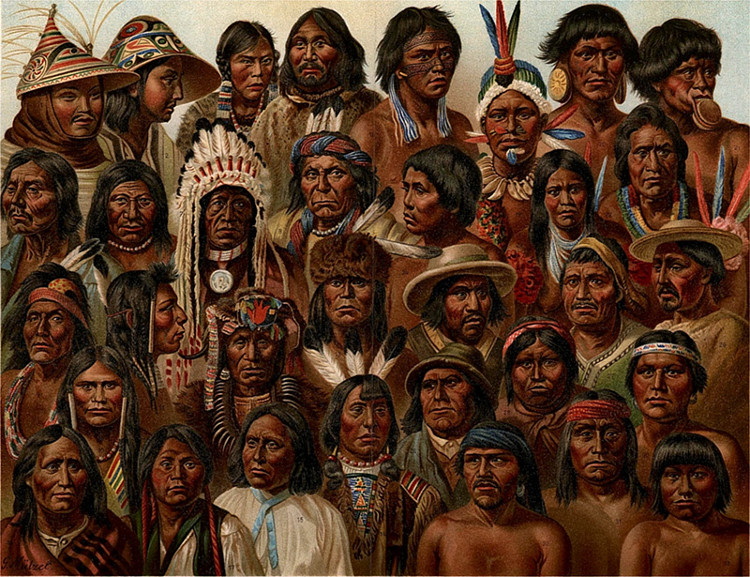How did prehistoric people come to America?
One of the most persuasive hypotheses is that prehistoric people traveled by road for 1,450km from Alaska to Montana. However, recent research by Danish, Canadian and American scientists has rejected this hypothesis.
Can't go by road
The question of how ancient people migrated to North America always attracted the scientific community. Hypothesis of the first inhabitants of America to the new world by road is most favored by people. Many scholars believe that by the end of the ice age - 13,000 years ago, temperatures began to rise, melting huge ice sheets covering Canada and northern America, opening a 1,450km long non-ice passage. zigzag from Alaska to Montana. The ancient people thus migrated from Asia to the Americas.
However, new research published by Mikkel Winther Pedersen - GeoGenetics Center, University of Copenhagen (Denmark) - rejected this hypothesis - according to the Nature Journal. The group has recreated the environment of the non-ice corridor to see if only living by hunting and gathering, ancient people could pass such long and arduous journey.

Native Americans came from Asia 23,000 years ago.(Photo: Wikimedia).
They also studied a series of lakes in western Canada along the aforementioned route, believing that there are still many layers of ancient sediments containing the DNA of the flora and fauna of this region for thousands of years.
Taking samples on cold ice lake to -300C is a difficult task. Another challenge is that ancient DNA has been destroyed too badly for analysis. Pedersen is forced to use the "shotgun" method : Collect all the DNA fragments in the specimen, analyze to find out which species of DNA belongs to the species before reorganizing.
All done, they were amazed when the ancient DNA from the bottom of the lake indicated that the non-ice corridor could not be human's habitat until 12,600 years ago - centuries after the first ancient people appeared. in the Americas. This shows that prehistoric people do not walk through this corridor.
"Our research has shown that these corridors simply open too late," said Mikkel Pedersen.
This result is consistent with a recent study by Beth Shapiro and Peter Heintzman of the University of California (USA). They rebuilt the genealogy of the bison living in the icy-free corridor and also came to the conclusion that the species could not live in the corridor until 13,000 years ago.
So if you can't go to America by road, how did the ancient people come here? According to Professor Loren Davis - Oregon State University (USA), they may go by sea or a combination of sailing and walking along the Pacific coast. However, finding evidence is difficult when most locations along the coastal route have been buried under water.
Ancient people came to America in a single wave
Prior to Pedersen's research, Loren Davis, Maanasa Raghavan and Eske Willerslev researchers - also from GeoGenetics Center, University of Copenhagen - published a remarkable study of the wave of migration to the Americas - according to the paper. Oregonstate.
To determine the origin of Native Americans today, experts have studied the sequences of modern human genomes from the Americas, Siberia and Oceania, comparing them to the specimens of the ancient people from Both branches of migration.

Today's ancestors of Native Americans entered the United States only once from Siberia to the Bering Strait and spread throughout the Americas.
Analyzing ancient and modern genetic data, the team found that today's ancestors of Native Americans entered the United States only once from Siberia to the Bering Strait and spread across the Americas more than 23,000 years ago. year. Later, this wave was divided into two groups of ancient people: Athabascans and Amerindians about 13,000 years ago.
They also hypothesize similar to Pedersen's group, that the ancestors of Native Americans moved along a path along the Pacific coast on the way to conquer the new world.
Later, the Amerindians as well as Athabascans split to spread across North America, while the Amerindians, the main groups, continued to advance to South America along the Pacific coast.
Scientists believe that this hypothesis closely matches archaeological evidence from prehistoric times.
"This research has great implications for the archaeological issues we are pursuing. Conclusion Native American ancestors can follow a Pacific coastal route to enter the Americas means they are We are on the right path to the important discoveries in the future " - Mr. Davis said.
- Footprints of 3.6 million years of prehistoric people reveal many secrets
- Deciphering the incredible life of prehistoric people
- Discovered a new prehistoric shark in America
- Life is equally amazing between modern people and prehistoric people
- New discovery about the custom of burial in the ice age
- Prehistoric people used to eat the dead relatives
- The prehistoric people once genocated large mammals
- The relics in the volcanic cave have bones of prehistoric people in Dak Nong
- Prehistoric people painted animals more beautiful than modern people
- Revealing the reason why prehistoric people cut their fingers
- Detecting traces of 'funeral funeral'
- Unexpected facts about the time of
 Discovered an ancient centipede fossil 99 million years old
Discovered an ancient centipede fossil 99 million years old Discovered bat-like dinosaurs in China
Discovered bat-like dinosaurs in China Discovered a 200-year-old bronze cannon of the coast
Discovered a 200-year-old bronze cannon of the coast Discover 305 million-year-old spider fossils
Discover 305 million-year-old spider fossils